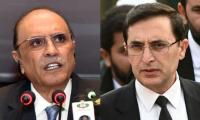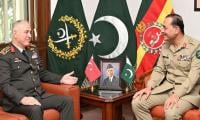One can agree with most things Pervez Hoodbhoy says on language (‘Is Pakistan’s problem Urdu?’ Dawn, March 5, 2016) and yet be left with the impression that he has painted with so broad a brush as to distract from the clarity of the issue and be actually misleading on some points.
Let us begin with the first part of his conclusion: “No nation becomes stronger by having the ‘correct’ official language.” Very true, but this does not imply that a nation cannot become weaker by having an ‘incorrect’ official language. For proof, just return to the beginning of the article where the author takes two paragraphs to assert the damaging effect of attempting to impose an ‘incorrect’ official language on East Pakistan. Not only did the nation end up weaker, it actually broke apart.
Next consider the second part of the conclusion: “Education cannot be improved by flipping from English to Urdu or vice versa. Change can happen only when education is seen as a means for opening minds rather than an instrument of ideological control.” No one will dispute the claim that opening minds is critical but that has more to do with the content of education and pedagogy than language. Even so, the question of which language would be more effective in opening minds in Pakistan – provided the intent is there – does not become irrelevant.
In this connection, the author himself states that “Using different mixes of bilingualism and even trilingualism… has enabled some [former colonies] to develop a better education for their young. Pakistan has not.” Clearly, if Pakistan were to emulate these countries, it would have to decide what mix of languages it would need.
Some of these contradictions have arisen because the author has not addressed separately the three quite different functions of language – as a means to cement nationhood, as a mode of communication between the rulers and the ruled, and as a medium of instruction in education.
Pervez Hoodbhoy is quite right that “nation-building needs more than a common language” but at the same time one cannot dismiss the functional need for an acceptable common language in a nation. It was indeed impossible to find one in 1947 but today, as the author points out, Urdu is Pakistan’s lingua franca. This remains an issue best addressed through the democratic process – citizens can decide whether Urdu can serve as the common language of Pakistan. If not, some other formula would need to be found.
Regarding communication, it is hard to imagine that real development can occur without being inclusive. How would we progress to a shared dialogue and vision for the country if the state continues to conduct its business in a language that “fewer and fewer people speak and understand”? It is this concern that motivated the Supreme Court to mandate Urdu for “official and other purposes.” The fact that “English stayed” is to be taken seriously as a failure to include citizens as full partners in the business of the country.
The most critical aspect of language is its function as the medium of instruction because it bears on the cognitive ability of new generations and thereby on the future of the country. The fact that it is yet to be addressed in Pakistan does not lessen its importance. Here, the author himself states that “Early learning happens fastest in the mother tongue, and only the tiniest fraction of Pakistanis speaks English at home.” How then can one be indifferent to the importance of having a ‘correct’ language policy for purposes of education?
It is a bit odd when the author goes on the state: “So go ahead and change the language to the ‘right’ one. You might get a 10 pc improvement at most.” The author does not clarify what the improvement would be in but whatever it may be, in a country of close to 200 million people a 10 pc improvement is not something that can be discounted so readily.
I am fully aware that Pervez Hoodbhoy, like many others, is frustrated by what is being taught in schools and the manner in which it is being taught. This is a contentious political and ideological struggle which does not make the choice of language irrelevant. In fact, even if nothing else changes, the use of languages more easily understood by those being educated would be a step in the positive direction.
In this context, one can subvert the author’s claim that “A parrot singing in Urdu or Sindhi understands no more than one who sings in English.” True enough, but for listeners it would be much easier to distinguish sense from nonsense if the parrot were singing in Urdu or Sindhi rather than in English.
The writer is on leave as vice-president and provost of Habib University.
Email: anjumaltaf@hotmail.com
A woman walks past a building of the International Monetary Fund. — AFP/FileThe annual and spring meetings of the...
Late Benazir Bhutto's daughter Asifa Bhutto Zardari addresses the Christian community in Bihar Colony on January 23,...
Representational image. — PexelsWater is an important scarce natural resource that is required for several everyday...
Pakistani employees of online marketplace company Kaymu at work in Karachi. — AFP/FileThe true spirit of development...
India uses Afghanistan as a backstage area to carry out terrorist attacks against Pakistan
Another report by the Pakistan Institute of Peace Studies states that 78 per cent of attacks have been carried out by...







